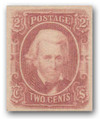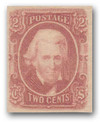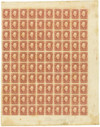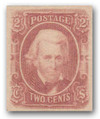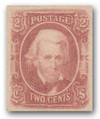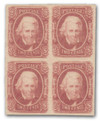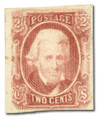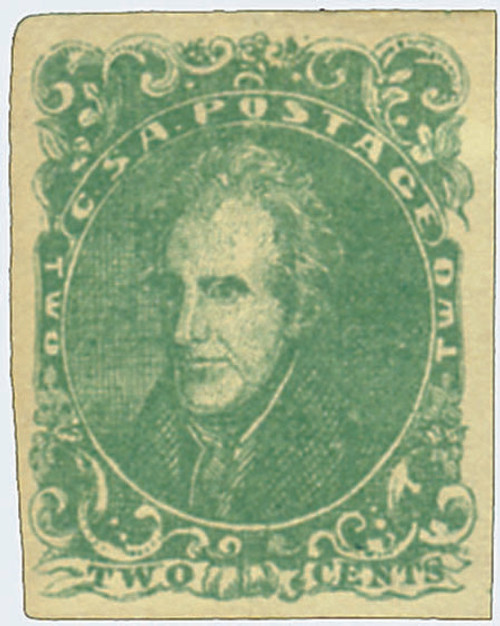
# CSA8 - 1863 2c Confederate States - Andrew Jackson - brown-red, soft paper, engraved (Archer & Daly)
1863 2¢ Jackson
A Sign of Progress For the South
Own a direct link to the tragic Civil War and a brief moment of hope for the beleaguered South.
Unlike the North, the South lacked the means to produce fine engraved stamps from steel plates. They relied on less desirable methods of lithography and typography to produce their stamps – until they lured John Archer away from the American Bank Note Company.
Archer moved from New York to Richmond and modified the central design of the 2¢ U.S. Jackson “Black Jack” stamp. The result was the striking 1863 2¢ Jackson – the first engraved stamp issued by the Confederate States of America. Hold history in your hands – order today.
Happy Birthday Andrew Jackson
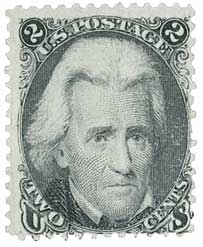
Andrew Jackson was born on March 15, 1767, in the Waxhaws area near the border between North and South Carolina.
Jackson received a minimal education in a small “old field school.” When he was 13, Jackson joined the American Revolution as a courier along with his brother Robert. The brothers were captured by British troops and nearly starved to death while being held as prisoners of war. They contracted smallpox and were eventually released by their mother’s bargaining. Within a matter of months Jackson’s mother and brother died, leaving him an orphan at age 14. He bitterly resented the British for the rest of his life.
After working briefly as a saddle maker and teacher, Jackson studied law in North Carolina. Admitted to the bar in 1787, he became a successful frontier lawyer. Jackson quickly proved himself as a tough and effective lawyer, often arguing cases over land claims, assaults, and battery. He went on to serve as a delegate to the Tennessee constitutional convention, served as a U.S. Representative when Tennessee became a state, and then as a Tennessee Supreme Court Judge.
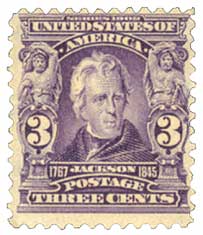
In 1801, Jackson resumed his military career when he was appointed colonel of the Tennessee militia. Leading the Tennessee militia, U.S. troops, Cherokee, Choctaw, and Southern Creek Indians, Jackson defeated the Red Stick Creeks at the Battle of Horseshoe Bend in 1814. He had another significant victory in January 1815 at the Battle of New Orleans. His heroics in there earned him the recognition of Congress and a gold medal.
During the First Seminole War Jackson took control of Pensacola, Florida removed the Spanish governor, and tried and executed two British subjects who had been helping the Indians attack his men. Stories of Jackson’s ruthlessness spread through the Seminole tribes and created an international incident. Secretary of State John Quincy Adams supported him and urged Spain to protect or cede the area to the U.S. As a result, the U.S. acquired the Florida Territory through the Adams-Onis Treaty.
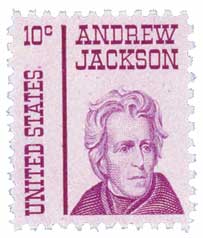
In 1824, Jackson ran for president. Though he had the most popular votes, he didn’t have a majority, so the decision was left to the House of Representatives, which selected John Quincy Adams. Jackson believed it was a “corrupt bargain.” This didn’t deter him and he ran again, and won, in 1828.
Jackson’s inauguration was the first presidential inauguration open to the public. With Jackson’s election, a new era in political philosophy was introduced: the Jacksonian Democracy. Jackson aimed to introduce equality for the common man, which he achieved in part by expanding voting rights to include all white male adults, rather than just landowners. This in part helped him achieve his goal of increasing public participation in government. In 1835, Jackson successfully lowered the federal debt to just $33,733.05, its lowest since 1791.
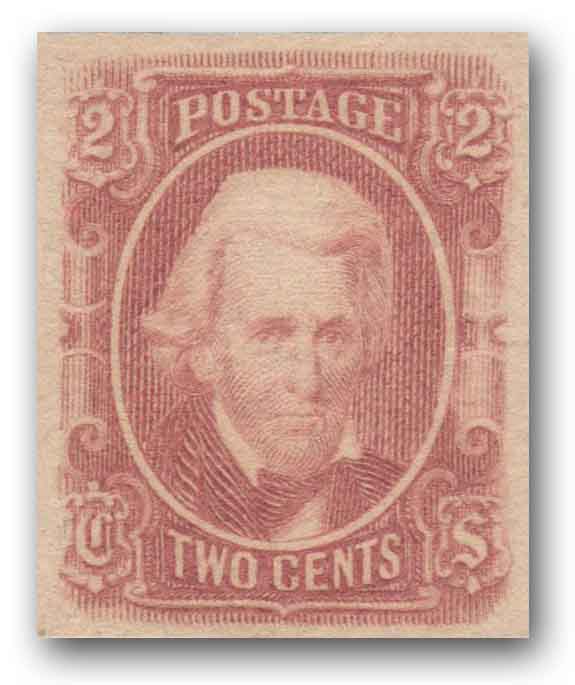
Jackson opposed the Second Bank of the United States, vetoed its request for a re-charter, and had all U.S. government funds removed to other banks. Then in 1836, he introduced the Specie Circular, requiring people who bought government land to pay in specie (gold or silver coins). The banks did not have enough specie, creating a greater demand that could not be filled. The banks that could not provide the money closed, causing the Panic of 1837, and a depression that lasted for years.
Jackson was also faced with another crisis while in office – the Nullification Crisis or Secession Crisis of 1828-32. Some people believed that high tariffs (the Tariff of Abominations) on European imports made those same goods more expensive than those from the Northern states, which raised the prices the Southern planters paid. Southerners felt that these high tariffs benefited Northern industrialists while hurting Southern farmers. Jackson told Congress that “The Constitution… forms a government not a league…To say that any State may at pleasure secede from the Union is to say that the United States is not a nation.” When the protectionists agreed to a Compromise Tariff, they retracted their Nullification Ordinance.
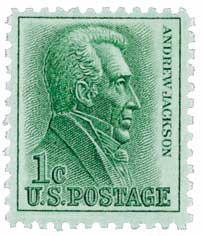
One of the most controversial issues of Jackson’s administration was his policy concerning American Indians. While Jackson said it was “unjust to compel the aborigines to abandon the graves of their fathers and seek a home in a distant land,” he also believed that “if they remain within the limits of the States they must be subject to their laws.” In 1830, he signed the Indian Removal Act, giving the President the authority to negotiate the purchase of Indian land in the east in exchange for lands west of the U.S. border.
This legislation was unpopular in the North, but Southerners supported it due to recent discoveries of gold on Cherokee land. A meeting between Cherokee John Ridge and U.S. politicians resulted in the Treaty of New Echota, which many Indians rejected because they did not see Ridge as their leader. Martin Van Buren then sent 7,000 troops to remove the Cherokees, resulting in over 4,000 Cherokee deaths along the “Trail of Tears.” In the end, over 45,000 American Indians were moved west, with the U.S. government purchasing nearly 100 million acres of Indian land plus an additional 32 million acres of western land.
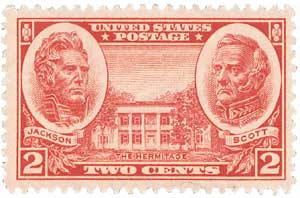
In 1837, Andrew Jackson retired to his Nashville home, The Hermitage. Even in retirement, he was an active voice in American politics. He had a large role in both of Martin Van Buren’s presidential campaigns, the first of which Van Buren won. Jackson helped in the acquisition of Texas and was a strong supporter of future President James K. Polk. Jackson died on June 8, 1845, from tuberculosis and heart failure.
1863 2¢ Jackson
A Sign of Progress For the South
Own a direct link to the tragic Civil War and a brief moment of hope for the beleaguered South.
Unlike the North, the South lacked the means to produce fine engraved stamps from steel plates. They relied on less desirable methods of lithography and typography to produce their stamps – until they lured John Archer away from the American Bank Note Company.
Archer moved from New York to Richmond and modified the central design of the 2¢ U.S. Jackson “Black Jack” stamp. The result was the striking 1863 2¢ Jackson – the first engraved stamp issued by the Confederate States of America. Hold history in your hands – order today.
Happy Birthday Andrew Jackson

Andrew Jackson was born on March 15, 1767, in the Waxhaws area near the border between North and South Carolina.
Jackson received a minimal education in a small “old field school.” When he was 13, Jackson joined the American Revolution as a courier along with his brother Robert. The brothers were captured by British troops and nearly starved to death while being held as prisoners of war. They contracted smallpox and were eventually released by their mother’s bargaining. Within a matter of months Jackson’s mother and brother died, leaving him an orphan at age 14. He bitterly resented the British for the rest of his life.
After working briefly as a saddle maker and teacher, Jackson studied law in North Carolina. Admitted to the bar in 1787, he became a successful frontier lawyer. Jackson quickly proved himself as a tough and effective lawyer, often arguing cases over land claims, assaults, and battery. He went on to serve as a delegate to the Tennessee constitutional convention, served as a U.S. Representative when Tennessee became a state, and then as a Tennessee Supreme Court Judge.

In 1801, Jackson resumed his military career when he was appointed colonel of the Tennessee militia. Leading the Tennessee militia, U.S. troops, Cherokee, Choctaw, and Southern Creek Indians, Jackson defeated the Red Stick Creeks at the Battle of Horseshoe Bend in 1814. He had another significant victory in January 1815 at the Battle of New Orleans. His heroics in there earned him the recognition of Congress and a gold medal.
During the First Seminole War Jackson took control of Pensacola, Florida removed the Spanish governor, and tried and executed two British subjects who had been helping the Indians attack his men. Stories of Jackson’s ruthlessness spread through the Seminole tribes and created an international incident. Secretary of State John Quincy Adams supported him and urged Spain to protect or cede the area to the U.S. As a result, the U.S. acquired the Florida Territory through the Adams-Onis Treaty.

In 1824, Jackson ran for president. Though he had the most popular votes, he didn’t have a majority, so the decision was left to the House of Representatives, which selected John Quincy Adams. Jackson believed it was a “corrupt bargain.” This didn’t deter him and he ran again, and won, in 1828.
Jackson’s inauguration was the first presidential inauguration open to the public. With Jackson’s election, a new era in political philosophy was introduced: the Jacksonian Democracy. Jackson aimed to introduce equality for the common man, which he achieved in part by expanding voting rights to include all white male adults, rather than just landowners. This in part helped him achieve his goal of increasing public participation in government. In 1835, Jackson successfully lowered the federal debt to just $33,733.05, its lowest since 1791.

Jackson opposed the Second Bank of the United States, vetoed its request for a re-charter, and had all U.S. government funds removed to other banks. Then in 1836, he introduced the Specie Circular, requiring people who bought government land to pay in specie (gold or silver coins). The banks did not have enough specie, creating a greater demand that could not be filled. The banks that could not provide the money closed, causing the Panic of 1837, and a depression that lasted for years.
Jackson was also faced with another crisis while in office – the Nullification Crisis or Secession Crisis of 1828-32. Some people believed that high tariffs (the Tariff of Abominations) on European imports made those same goods more expensive than those from the Northern states, which raised the prices the Southern planters paid. Southerners felt that these high tariffs benefited Northern industrialists while hurting Southern farmers. Jackson told Congress that “The Constitution… forms a government not a league…To say that any State may at pleasure secede from the Union is to say that the United States is not a nation.” When the protectionists agreed to a Compromise Tariff, they retracted their Nullification Ordinance.

One of the most controversial issues of Jackson’s administration was his policy concerning American Indians. While Jackson said it was “unjust to compel the aborigines to abandon the graves of their fathers and seek a home in a distant land,” he also believed that “if they remain within the limits of the States they must be subject to their laws.” In 1830, he signed the Indian Removal Act, giving the President the authority to negotiate the purchase of Indian land in the east in exchange for lands west of the U.S. border.
This legislation was unpopular in the North, but Southerners supported it due to recent discoveries of gold on Cherokee land. A meeting between Cherokee John Ridge and U.S. politicians resulted in the Treaty of New Echota, which many Indians rejected because they did not see Ridge as their leader. Martin Van Buren then sent 7,000 troops to remove the Cherokees, resulting in over 4,000 Cherokee deaths along the “Trail of Tears.” In the end, over 45,000 American Indians were moved west, with the U.S. government purchasing nearly 100 million acres of Indian land plus an additional 32 million acres of western land.

In 1837, Andrew Jackson retired to his Nashville home, The Hermitage. Even in retirement, he was an active voice in American politics. He had a large role in both of Martin Van Buren’s presidential campaigns, the first of which Van Buren won. Jackson helped in the acquisition of Texas and was a strong supporter of future President James K. Polk. Jackson died on June 8, 1845, from tuberculosis and heart failure.



